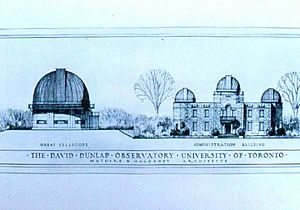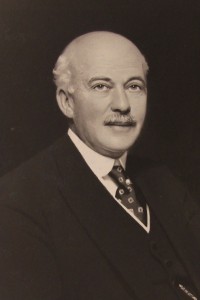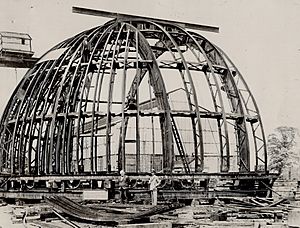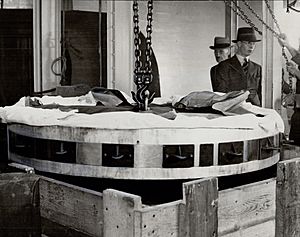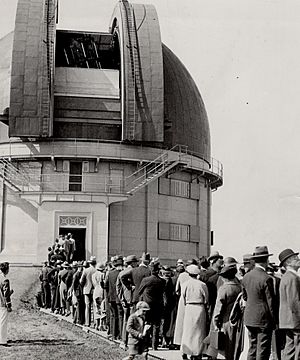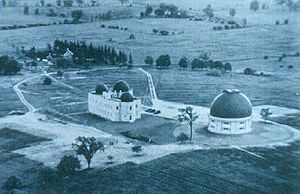David Dunlap Observatory facts for kids
Quick facts for kids David Dunlap Observatory |
|||||||||
|---|---|---|---|---|---|---|---|---|---|
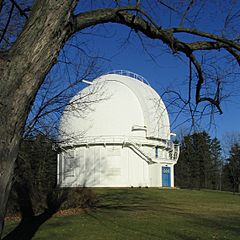
The 74-inch (1.9 m) telescope at the David Dunlap Observatory
|
|||||||||
| Organization | University of Toronto (1935–2008) Royal Astronomical Society of Canada (2009–2016) City of Richmond Hill (2018-) |
||||||||
| Location | Richmond Hill, Ontario, Canada | ||||||||
|
Coordinates
|
43°51′46″N 79°25′22″W / 43.8629°N 79.4227°W
|
||||||||
| Altitude | 224 m (735 ft) | ||||||||
| Weather | 67% clear nights[1] | ||||||||
| Established | 31 May 1935 | ||||||||
| Website astro.utoronto.ca/DDO (1935-2008), www.theddo.ca (2009-2016), |
|||||||||
|
|||||||||
The David Dunlap Observatory (DDO) is a special place for looking at stars and planets. It is an astronomical observatory located just north of Toronto, in Richmond Hill, Ontario. It opened in 1935 and was first run by the University of Toronto. Since 2018, the City of Richmond Hill has owned and operated it. They keep it as a historic site and offer fun activities for everyone.
The main telescope at the DDO is a huge 74-inch (1.88 m) reflector telescope. When it was built, it was the second-largest telescope in the world! Today, it is still the biggest telescope in Canada. The DDO has been important for many scientific discoveries. For example, scientists there measured how far away some star clusters are. They also found the first proof that Cygnus X-1 was a black hole. Another discovery was that the star Polaris was changing and no longer fit into a certain star group. Because the city has grown around it, it's harder to see faint objects in the sky from the DDO now. On July 31, 2019, the DDO was named a National Historic Site of Canada.
Contents
History of the Observatory
How it Started
The David Dunlap Observatory exists mostly thanks to one person, Clarence Chant. He became interested in mathematics and physics at the University of Toronto. In 1892, he started teaching physics there. Chant later earned his PhD from Harvard University.
Chant joined an astronomy club in 1892, which later became the Royal Astronomical Society of Canada. He was the president of this club from 1904 to 1907. Chant was worried that the university wasn't doing enough for astronomy. In 1904, he suggested adding more astronomy courses for students.
After the courses were added, Chant wanted to find a good telescope for the university. The university used to have a telescope, but new buildings had grown up around it. This made it useless for looking at the stars. The old telescope was also quite small compared to others being built around the world.
Chant realized that the university grounds were not a good place for a new observatory. So, he started looking for land outside the campus. He found a perfect spot in 1910, a 10-acre (40,000 m2) piece of land. It was near what is now Bathurst Street and St. Clair Avenue. The city had planned to use this land for a hospital, but it was never built. Chant tried to get the city to help build an observatory, but World War I stopped the project. It was completely cancelled in 1919.
Dunlap Family Helps Out
Chant then looked for money from local businesses. This had worked well in the United States, but not in Canada. Things changed in 1921 when Chant gave a public talk about a comet. One person in the audience was Hollinger Mines co-founder, lawyer David Dunlap. He became very interested in astronomy after the talk. Dunlap wanted to help Chant build a large observatory.
Sadly, Dunlap died in October 1924. Chant then spoke to Dunlap's widow, Jessie Dunlap, in 1926. He suggested building an observatory to honor her husband. Mrs. Dunlap liked the idea a lot.
By this time, the first land Chant found was too close to the city lights. A new location was needed, much further away. This would make sure it wouldn't get too much light pollution. After looking at a few places, a good spot was found north of the city. It was near Yonge Street and a railway line. When Chant showed Mrs. Dunlap the site, she said, "this is the place!" She agreed to buy the land for C$28,000.
Building the Observatory
Chant quickly ordered a 74-inch (1.88 m) telescope from Grubb, Parsons and Company in England. This would make it the second-largest telescope in the world at the time. Only the 100-inch telescope at Mount Wilson Observatory was bigger. The observatory building began construction. The huge copper dome, weighing 80 tons, was built in 1932 and arrived in 1933.
The main mirror, which is 76 inches (1.93 m) wide, was made by Corning Incorporated. It was made from a special glass called Pyrex. Chant and Mrs. Dunlap watched the mirror being made in June 1933. The mirror was then sent to England to be polished. The telescope was finished in May 1935 when the mirror returned.
The observatory officially opened on May 31, 1935. This was also Chant's 70th birthday. Important people like former Prime Minister William Lyon Mackenzie King attended the ceremony. King praised the observatory as "a gift to science all over the world." Chant retired that same day.
Other similar telescopes were built by Grubb-Parsons in other countries. The DDO's telescope remained the largest in Canada for many years.
The DDO administration building has three smaller domes on top. In 1935, a 50 cm telescope was put in the southern dome. Later, in 1951, a 6-inch (150 mm) telescope was moved into the northern dome for students to use. In 1965, a 60 cm telescope was added to the central dome.
How it Operated
From 1946 to 1951, Frank Scott Hogg was the observatory director. His wife, Helen Sawyer Hogg, also worked there. After her husband passed away, Helen continued her work. She studied star clusters to figure out their distances. She also wrote a popular weekly newspaper column called 'With the Stars'.
In 1956, a radio telescope was built at the observatory. This was a joint project with the Electrical Engineering Department. The DDO also built a larger 18 m radio telescope in Algonquin Provincial Park. This telescope was used until 1991.
In 1960, the observatory was featured in a short film called Universe. This film was nominated for an Academy Award. It was even seen by Stanley Kubrick and Arthur C. Clarke, who were working on the famous movie 2001: A Space Odyssey.
In 1971, astronomer Tom Bolton used the DDO telescope for an important discovery. He used data from X-ray telescopes to study Cygnus X-1. He proved that a star called HDE 226868 was the source of X-ray emissions. His work helped show that Cygnus X-1 was indeed a black hole.
Changes Over Time
As the university grew, more astronomy offices moved to the downtown campus. The main library at the DDO also moved downtown in 1983. The old Cooke Refractor telescope was given to the Canada Science and Technology Museum in 1984.
The main telescope at the DDO was still very important in the 1960s. However, the city was growing, and light pollution became a problem. Instead of moving the large telescope, the university decided to build a smaller one in a better location. This led to the building of a 60 cm telescope in Chile in 1971. This new observatory was called the University of Toronto Southern Observatory (UTSO).
At the UTSO, a University of Toronto telescope operator named Ian Shelton discovered Supernova 1987A. This was the first supernova visible to the naked eye in over 350 years! The UTSO closed in 1997. The university then joined the Gemini Observatory project.
Big Telescopes of 1935
When the David Dunlap Observatory opened in 1935, its main telescope was the second-largest in the world. Here are some of the biggest telescopes back then:
| # | Name / Observatory |
Image | Size | Altitude | First Light |
Key Person |
|---|---|---|---|---|---|---|
| 1 | Hooker Telescope Mount Wilson Obs. |
100 inch 254 cm |
1742 m (5715 ft) |
1917 | George Ellery Hale Andrew Carnegie |
|
| 2 | David Dunlap Observatory | 74 inch 188 cm |
224 m (735 ft) |
1935 | Clarence Chant | |
| 3 | Plaskett telescope Dominion Astrophysical Obs. |
72 inch 182 cm |
230 m (755 ft) |
1918 | John S. Plaskett | |
| 4 | 69-inch Perkins Telescope Perkins Observatory |
69 inch 175 cm |
1931–1964 | Hiram Perkins | ||
| 5 | 61" reflector Oak Ridge Observatory |
61 inch 155 cm |
1933 |
Later in the 1930s, an 82-inch telescope was built in Texas. By the 1940s, the Dunlap telescope was still the fourth largest. It remained the largest telescope in Canada until 1992.
Fun Facts
The David Dunlap Observatory has appeared in TV shows! It was featured several times in the NBC series Hannibal. The administration building looked like a hospital in the show. The Observatory also appeared in the Netflix show The Umbrella Academy.
See also
 In Spanish: Observatorio David Dunlap para niños
In Spanish: Observatorio David Dunlap para niños


